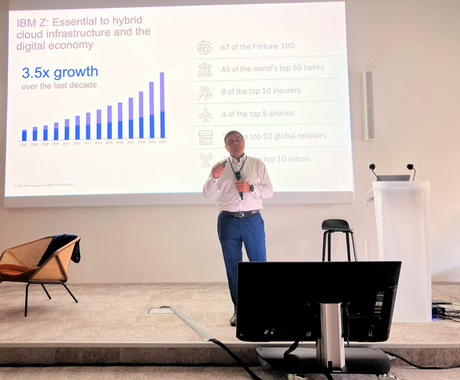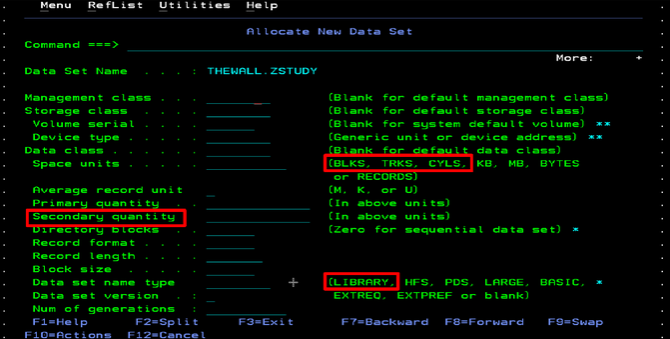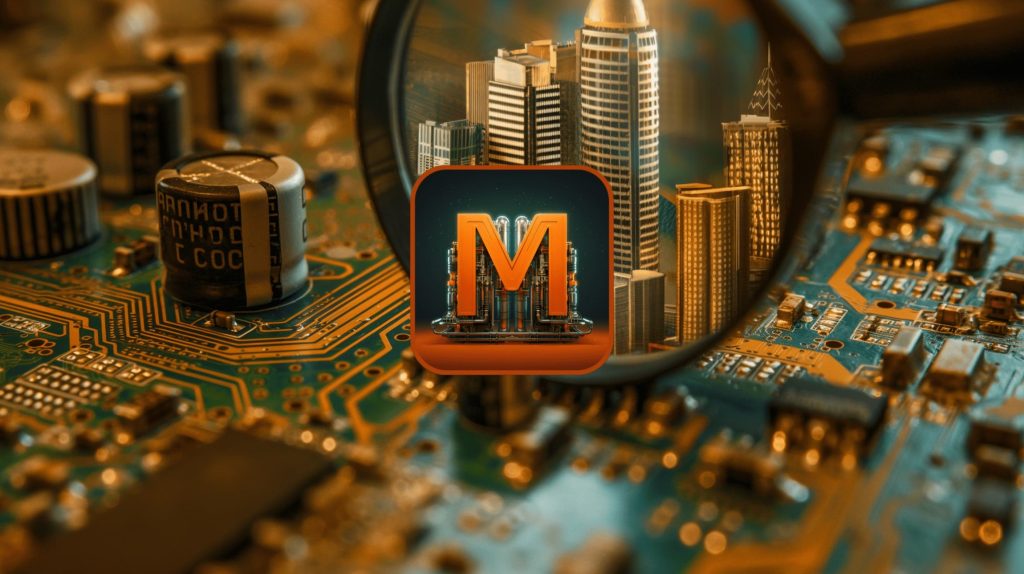Dear fellow mainframer,
September treated me well. I enjoyed Indian summer with lots of cycling adventures, 2-day gravel bike-touring in Velebit mountain, climbing from sea level to 1400 m peak. I seized the opportunity and went for Saturday’s club ride in Paris and a nice tour around Montpellier.
However, what really excites me is the passion and new energy I sensed in the mainframe community recently. The crowd in Montpellier and Tobias Leicher are both telling me it is a good time to be a mainframer.
Fireside chat with Tobias Leicher
Ta-da! Welcome to my very first interview for the Mighty Mainframe. I had the pleasure to chat with Tobias Leicher, an IBM Client Architect. As a true mainframe aficionado, he is very knowledgeable about all things mainframe but is also such an incredibly well-rounded professional and individual.

I asked Tobias about future-proofing the mainframe platform and how he sees “mainframe modernization”. His answer was very lively and technically precise: “We need in-place modernization to close the technical debt.” He adeptly described why we need mainstream DevOps on the mainframe, Python vs. REXX, and Cobol vs. Java, and I especially liked the metaphor about “vegan sausages”. Not to spill all the tea, watch the full interview by clicking the button below.
Watch the full interview here →
Good news for VSE customers
There is a big community of loyal VSE customers all around the globe. IBM designed VSE back in 1970, with the idea of making it a simpler and more accessible version of MVS operating system. Fast forward to 2023, some customers migrated to z/OS (or planning to do it), few migrated to other platforms, but quite a few customers remained loyal to VSE.
In a significant move for the VSE community, a modernized version of the z/VSE operating system for IBM Z mainframes – VSEn V6.3 was announced. It aims to give IT leaders greater control over their IBM Z infrastructure, while also reducing the need for specialized skills in managing these systems. One of the standout features is its compatibility with the latest z16 mainframe hardware. The middleware stack names have been updated for branding purposes, but the executables remain unchanged to ensure a seamless transition for existing users.
The company is also collaborating with other vendors to bolster the VSE ecosystem in key areas such as security and cloud offerings. From today’s standpoint, VSEn V6.3 promises to be a comprehensive upgrade and a signal of a commitment to keep the platform alive and updated.
Building API layer on top of mainframe
The mainframe team at CROZ has been quite busy recently helping customers to deliver in-place modernization projects. One of the most common requirements is to integrate the mainframe with the “brave new world”. Building an API layer on top of the mainframe proved to be the best practice.
Our engineers are very eager to share their knowledge and they went live on a webinar a few weeks ago. They highlighted the use of API-centric architectures to expose mainframe functionalities, thereby enabling interoperability with contemporary systems and facilitating DevOps workflows.
The discussion also covered key considerations such as security protocols, data transformation, and system latency, which are critical for ensuring a robust and scalable API layer. The Q&A session touched on the complexities of middleware, data synchronization, and the potential ROI, offering actionable insights for modernizing legacy systems without compromising their inherent reliability.
If you missed the webinar – click the button below for the recording, including the Q&A session.
Check out our first webinar here →
IBM zStudy Tour 2023, Montpellier
I attended the 3-day briefing for mainframe customers and business partners from Nordics, Benelux and Central Europe in Montpellier. My biggest takeaway? It is a good time to be a mainframer.
IBM’s continuous investment in technology (just think of 7nm chips with large onboard cache), and especially software stack (containers, DevOps, hybrid cloud….) has reached such a level that mainframe now natively supports all relevant technologies and tools. Mainframe users realise there is no time for further procrastination (primarily because of the widening skills gap) and wholeheartedly adopt in-place modernization. Tobias Leicher perfectly describes this “zeitgeist”.
The conference kicked off on a high note with an insightful opening keynote by Jose Castano, IBM’s Vice President of zStack. He described “the perfect storm” that has recently impacted the mainframe community. This storm comprises three critical factors: technological advancements, the urgent need for modernization due to a skills gap, and the rapid pace of digital transformation.

Previously viewed as a hindrance to digital progress, mainframes have now emerged as centres of reinvention. To substantiate this shift, Jose presented compelling data. For instance, the revenue generated by IBM’s z15 program exceeded that of its predecessor by more than 100% over the first two years. Additionally, the IBM z15 set new records for capacity shipped, and the z16 launch turned out to be the most successful in the past 22 years, showing a 77% year-over-year growth.
There was plenty of useful information, brought by experienced speakers in a very practical and straightforward way. Here are a few points from my notebook:
Key takeaways
– DORA (Digital Operational Resilience Act) is here, around the corner. It is a new EU regulation that will take effect on January 17th 2025, and it applies to all financial organizations across the EU, but it is basically a set of best practices focused on cyber resilience (therefore it is applicable globally), but this time the auditors will do real hands-on verification. The good news is that mainframe is already well-equipped for DORA: RACF, zSecure, GDPS, DS8K – SafeGuardedCopy, pervasive encryption, EKMF, Cyber Vault. Everything’s here, but make sure that you configure the tools properly, and implement the security policy.
– Mainframe offers plenty of options for containerization. IBM introduced the zCX back in 2017. Today, you can run containters in Secure Service Container (outer envelope), zCX (Container Extension) as an envelope inside z/OS, Openshift RedHat Container Platform, Canonical Openstack (Cloud Computing Infrastructure) , natively on top of any of supported Linux distributions. The advantages of containerizing z/OS applications are numerous. It provides isolation between the application and infrastructure layers, leverages mainframe architecture for resource sharing, and enables a variety of use cases like automatic environment provisioning for tests, concurrent version testing, and application relocation.
– Everybody remembers the big announcement of z16, and the new Telum chip that incorporates on-chip AI Accelerator. But how to put it to use in real life? One year after the announcement, the full software stack is here, and it is fully compliant with industry frameworks and standards such as TensorFlow, PyTorch, ONNX… Good news for data scientists and AI practitioners – you can build and train the models anywhere, and then deploy the runtime on mainframe using Watson Machine Learning for z/OS and IBM DLC (Deep Learning Compiler). It is especially useful for heavy transactional workloads that need real-time inference.
– Why open-source automation is very important part of mainframe modernization? How many of you know what is ZOAU? And able to pronounce it ZOAU stands for IBM Z Open Automation Utility which provides Unix-like commands for z/OS. It’s not a new tool, and many of seasoned mainframers would say “So what ?!? “ But, Frank van der Wal, explained why Ansible is so popular these days (because it’s 2023!) and why Python scripts are still a good idea, even though JCL is the best thing that happened to mankind after fire and the wheel.


Empowering Mainframe Teams with Managed Services
In our latest blog post, we delve into the strategic advantages of employing “Managed Services” for mainframe operations. This model is not mere outsourcing; it’s an integrated approach designed to augment your existing team’s capabilities. CROZ experts assume responsibility for specific components of your mainframe infrastructure, thereby filling skill gaps, reducing operational costs, and enhancing service quality.
The Managed Services model allows you to retain full ownership and control over your mainframe hardware and software licenses. Our specialists work in tandem with your team, focusing on both routine maintenance and advanced optimization strategies. The objective is to transform your mainframe infrastructure into a strategic asset that aligns with your organization’s long-term goals.
From implementing API-centric architectures to introducing modern DevOps tools, our experts provide solutions that go beyond mere incident resolution. This collaborative approach ensures not only the smooth functioning of daily operations but also paves the way for continuous improvement and innovation.
For organizations looking to shift their focus from day-to-day operations to strategic objectives, our upcoming blog post will serve as a comprehensive guide to achieving this transition effectively.
Falls Sie Fragen haben, sind wir nur einen Klick entfernt.


